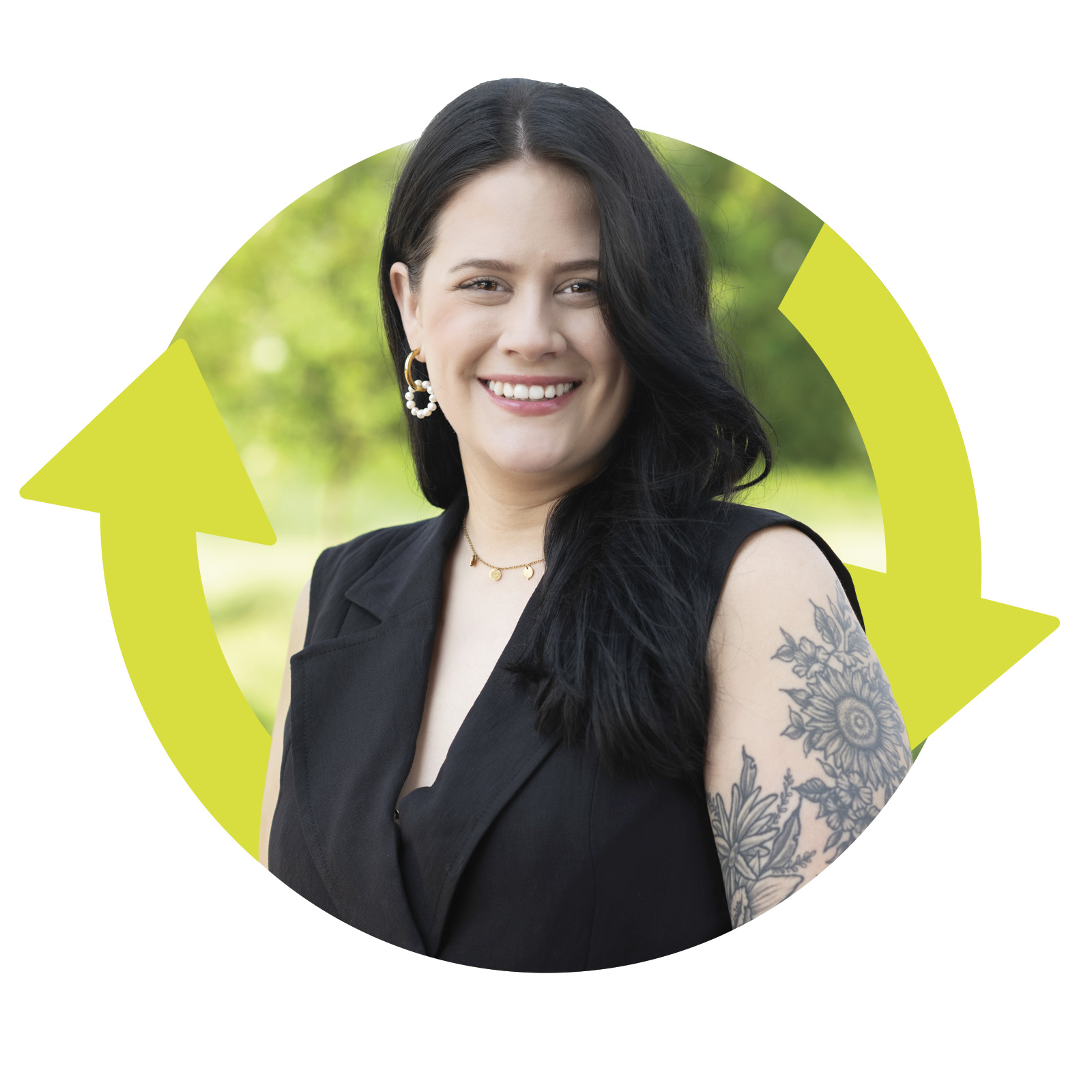
Previously, when Sanjukta Pookulangara wanted a new sweater or casual dress for her wardrobe, she would peruse the racks at a brick-and-mortar retail store. These days, she's inclined to select gently used garments from a website that rents or sells her favorite clothing brands at discounted prices.
Although the professor and chair of merchandising and digital retailing at UNT's College of Merchandising, Hospitality and Tourism is new to shopping for secondhand clothing, Pookulangara is well acquainted with the rapidly expanding marketplace. In 2023, she and CMHT professor and associate dean Jiyoung Kim and assistant professor Iva Jestratijevic -- with the assistance of CMHT senior fashion merchandising major Caroline Bowen -- wrote and published the first educational case study about the fast-growing retail trend of recommerce.
Also known as reverse commerce or circularity, it is the practice of trading and selling preowned goods, including clothing and other apparel, through physical and online platforms. Its popularity is on the rise, especially among Gen Z and Millennial consumers who tend to favor more eco-friendly, sustainable sales, one-of-a-kind items and discounted shopping options.
Hundreds of international fashion brands -- including Patagonia, Frye and Lululemon -- operate "branded resale" channels to recirculate their own merchandise. Items typically are purchased from or traded in by previous and existing customers before they're "refurbished," marketed and sold to shoppers who may be new to the brand. Others use third-party recommerce providers such as threadUP and Trove to resell their garments. Meanwhile, "peer-to-peer" platforms -- including Poshmark, Depop and eBay -- allow consumers to take the lead in selling clothes sourced directly from their closets.
"It is one of the biggest trends in the fashion industry," Kim says. "It's a lifestyle choice. You can try new brands, and it's giving shoppers access to higher-end brands."
UNT alumni whose careers are in the fashion industry also are monitoring the rapid recommerce expansion among apparel manufacturers, retailers and consumers.

"It opens up the door to keeping goods in circulation for a longer time," says Matthew Blair ('19), who studied fashion merchandising at CMHT prior to joining Lewisville-based The Apparel Group, where he served as their sustainable material sourcing and fabric development executive. TAG's parent company is TAL Apparel, an international garment manufacturer committed to sustainability. He currently works for Austin based apparel maker Tecovas as an associate apparel product developer.
Sustainable practices have not always been a priority for the fashion industry, which is responsible for about 10% of all global carbon emissions. "It hasn't been until recently that we've been getting notice on the impact that apparel has," he says. "The landfills are piling full of apparel waste. It's really come to the point where it's do or die for our industry."
Giving existing garments multiple lives "inherently is more sustainable than having to start all the way over from the beginning of the manufacturing process," Blair says. Also, "creating consumer education about why that's better will help take down any stigmas there may be about buying secondhand or through a recommerce platform."
Sustainable Shopping
CMHT faculty produced the case study in partnership with the NRF Foundation, a nonprofit that provides access to education and opportunities needed for successful retail careers. In 2023, the foundation awarded Pookulangara, Kim and Jestratijevic a $10,500 grant to support their research. The collaboration marked the first time the organization had worked with a U.S. university on a case study -- the findings of which were presented in 2024 to educators and others attending the annual NRF Foundation Student Program conference in New York City.
"Recommerce is reshaping the retail landscape and this case study shines a light on this rapidly growing market," says Adam Lukoskie, executive director of the NRF Foundation and senior vice president of the National Retail Federation.
The study "showcases the vital role of retail in the economy and the transformative impact of recommerce," Pookulangara says. "We hope it also piques student interest and encourages them to delve into merchandising as both a significant career and educational choice, specifically by exploring CMHT's digital retailing program."
CMHT dean Jana Hawley, a sought-after expert on textile recycling, says the NRF collaboration is especially fitting since UNT is the only university in the nation to offer a bachelor's in digital retailing. "The case study is a valuable tool to be used by educational programs and companies from across the nation to learn more about recommerce as a strategy that reduces apparel waste and contributes positively to the circular apparel economy."

The UNT researchers interviewed directors of circularity and other executives at seven international fashion brands to learn about the $100 billion global recommerce market, which is growing five times faster than the broader retail market. That growth is largely attributed to the environmental impact and sustainability factors of recirculating product to consumers.
"Sustainability is central to recommerce because inherently its purpose is to extend the lifecycle of products," says Jamie Atkins ('19), who earned dual degrees in merchandising and digital retailing at UNT. The Frisco resident is a research analyst with New York City-based Circular Services Group, which devises circularity solutions for fashion industry companies.
Atkins, who earned an M.B.A. in sustainability from New York's Bard College, is a circular shopper. She hopes more consumers will embrace recommerce -- and more retailers will explore the practice. "It can be a very important strategy of circular solutions for waste. It lowers the demand for new materials and the associated carbon footprint of producing those new goods. It also encourages more sustainable consumer behavior by valuing secondhand items to maintain them longer."
Hunting For Treasures
For retailers, however, the recommerce business model is not without its challenges. Increased labor costs tend to make it more lucrative for larger fashion brands than smaller ones. Brands of all sizes struggle to gauge unpredictable supply-and-demand levels for products as well as shifting price points. The CMHT case study found that luxury and athleisure-wear brands tend to fair better as high-end apparel typically retains its value even with recommerce's discounted pricing.
Still, Kim says, "The advantages of recommerce are pretty well-known. It is beneficial for sustainability efforts. It brings additional profits to brands. It gives customers more options."

While studying for his master's degree in merchandising, Cody Henson ('13, '22 M.S.) received funding from UNT's Center for Consumer Insights and Innovations to research fashion-ownership redistribution in the secondhand-apparel market. The center works to advance consumer insights through industry and academia collaboration.
Through his research, Henson -- a buyer for Kay Jewelers, which is owned by Coppell-based Signet Jewelers -- found that a growing number of young consumers begin their "shopping journeys" within the secondhand marketplace.
"An individual's need for uniqueness, for the element of bringing substance to self-expression, is a really important part of recommerce shopping," Henson says. "Consumers are looking for something special that's going to help them express their identity, their values and what they believe in" through their personal styles and wardrobes.
Secondhand shopping boasts a "treasure-hunting component" as well that adds to its appeal. "You never know what you're going to find until you find it, and there's a good dopamine hit that comes with finding something super exciting," he says.
'Well-Educated' Consumers
Pookulangara, Kim and Jestratijevic have collected additional data to expand the original recommerce educational case study, which they presented in 2024 at the International Conference on Clothing and Textiles in South Korea and the International Textile and Apparel Association's annual conference in Long Beach, California. They hope to publish the study in a research journal this year.
The professors have hosted focus groups with Gen Z shoppers, who tend to be tech savvy and conscious about price, quality and sustainability. Members of that generation are concerned about "greenwashing" -- misleading or false claims about the environmental benefits of products and services -- as well as the potential negative impact large recommerce platforms could have on small, independently owned thrift and vintage stores. "Their viewpoint as customers is well-educated," Kim says.
The original educational case study has been made more user friendly for the 50,000 students of high schools, community colleges and workforce development organizations who participate in the NRF Foundation's RISE Up training and credentialing program annually.
Despite being in its infancy, Kim says recommerce will likely remain in vogue for decades to come.
"Everyone is trying it out. Some of the models will remain sustainable and robust -- business-wise, profit-wise and in terms of their ecological impact," she says. "The recommerce market will not stop growing."